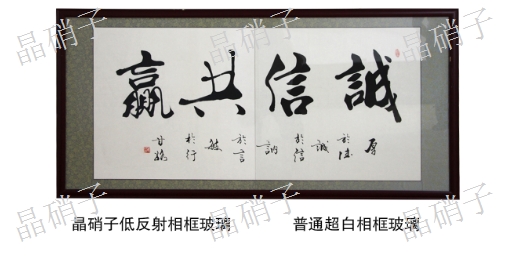Low-reflective picture frame glass plays an important role in protecting valuable paintings and drawings in museums. It has several functions and features that provide quality protection and display. The following will detail how low-reflective picture frame glass can protect paintings and drawings in museums.

Firstly, low-reflection picture frame glass has a visible light transmission rate of over 99 per cent, which means that it blocks virtually no visible light from entering. This is important for paintings and drawings in museums, as they need enough light to show detail and colour. Low-reflective picture frame glass effectively reduces reflections, allowing viewers to see the work clearly, while also increasing the brightness of the work and enhancing the viewing experience.
Secondly, low-reflection picture frame glass has a low reflectivity, typically less than 0.8 per cent. This means that when exposed to bright light, the picture frame glass will not reflect significantly, thus alleviating the problem of whitening the picture due to the bright light behind it. As a result, viewers can better appreciate the artwork and view the image without being distracted by unwanted reflections. Low reflectivity also helps to improve image quality, making the display of paintings and calligraphy clearer.
Thirdly, low-reflection picture frame glass can enhance the colour brilliance and contrast of the artwork. It can effectively reduce light scattering and interference, providing better colour reproduction. By reducing reflections, low reflection picture frame glass allows viewers to better appreciate the rich and vivid colours in the artwork, while enhancing the contrast of the picture, making the image more vivid and three-dimensional.
Fourthly, low-reflection picture frame glass is UV resistant. It can significantly reduce the transmittance rate of the ultraviolet spectral region, thus effectively blocking the damage of ultraviolet rays to the painting and calligraphy works. UV rays are one of the main factors that cause fading and damage to works, and low-reflection picture frame glass can provide additional protection to extend the life of the works and ensure that they are displayed and preserved for a long period.
Additionally, low-reflection picture frame glass is heat and scratch-resistant. With a temperature resistance of over 500 degrees, it can be used in a variety of environments and will not be deformed or damaged by high temperatures. Meanwhile, the film layer on the surface of the picture frame glass has a high hardness of greater than 6H, which has desirable wear resistance and can effectively prevent scratches and damage.
In addition, low-reflection picture frame glass is easy to clean. It can withstand wiping with various cleaners, including acid and alkali cleaners, without damage. This makes it easier to protect and maintain calligraphy and paintings with sustainable transparency and clarity.
Finally, low-reflective picture frame glass maintains a stable viewing angle. In contrast to typical glazing materials that cause the viewing angle to diminish after installation, low-reflective picture frame glass does not suffer from this problem. This means that the viewer gets a consistent visual effect and viewing experience, no matter what angle the work is viewed from.
In summary, low-reflective picture frame glass plays an important role in the protection of valuable paintings and drawings in museums. It presents a clearer, brighter and more realistic picture to the audience by providing high transparency, reduced reflection, enhanced colour and contrast, and UV protection. At the same time, its temperature-resistant, scratch-resistant and easy-to-clean properties make it easier to protect and maintain the artwork. Widely used in museums, low-reflective picture frame glass can effectively enhance the display of works and protect precious cultural heritage in the long term.





